When comparing Zigbee and KNX, you'll notice key differences. Zigbee uses a low-power mesh network for easy device integration, making it great for smart homes. It supports a wide range of devices but can face interoperability issues. On the other hand, KNX relies on a wired bus topology, offering precise control but requiring professional installation. It's highly consistent within its ecosystem but can involve complex setups. Cost-wise, Zigbee typically has lower initial expenses and is easier for expansions. Understanding these differences can help you choose the right protocol for your needs. Stay tuned for deeper insights!
Key Takeaways
- Zigbee operates on a wireless mesh topology, promoting low power usage and easy device integration, while KNX uses a wired bus topology for precise control.
- Zigbee has a larger ecosystem of devices, whereas KNX maintains a consistent but limited selection, ensuring high interoperability within its network.
- Installation of Zigbee is user-friendly and requires minimal effort, while KNX typically demands professional installation and possible retrofitting due to its wired nature.
- Zigbee generally incurs lower initial and ongoing costs, making expansions easier, while KNX may have higher installation costs due to its complexity.
- Both protocols offer advanced security features, including encryption and authentication, but the ease of integration and configuration varies significantly between them.
Communication Protocols Overview

When it comes to smart home systems, understanding the communication protocols is essential for effective implementation. Zigbee and KNX utilize different approaches to connect devices, and making an informed choice can be as important as setting a budget for managing income effectively.
Zigbee operates on the IEEE 802.15.4 standard, emphasizing low power usage and enabling a mesh network topology. This allows devices to communicate directly, enhancing reliability and range.
On the other hand, KNX employs a wired standard that supports wireless communication, using a bus topology to connect devices via a shared line. While both protocols offer hybrid options for flexibility, Zigbee's mesh design is particularly suitable for low-power devices.
In contrast, KNX's bus topology requires programming for new device integration, making it imperative to choose the right protocol based on your specific needs and installation environment.
Network Topologies Explained

Understanding network topologies is essential for optimizing smart home systems, as they dictate how devices communicate and function together.
For effective implementation, consider the impact of content relevance and authority on your selection process.
Zigbee utilizes a mesh topology, enabling devices to connect directly with one another. This enhances reliability and range, making it perfect for low-power devices. With Zigbee, as you add more devices, the network becomes even more robust.
On the other hand, KNX employs a bus topology, where devices are linked through a shared line. This setup allows for precise control but may require additional programming for new device integration.
Both topologies offer unique advantages, so consider your specific needs when choosing between Zigbee and KNX for your smart home.
Device Compatibility Insights
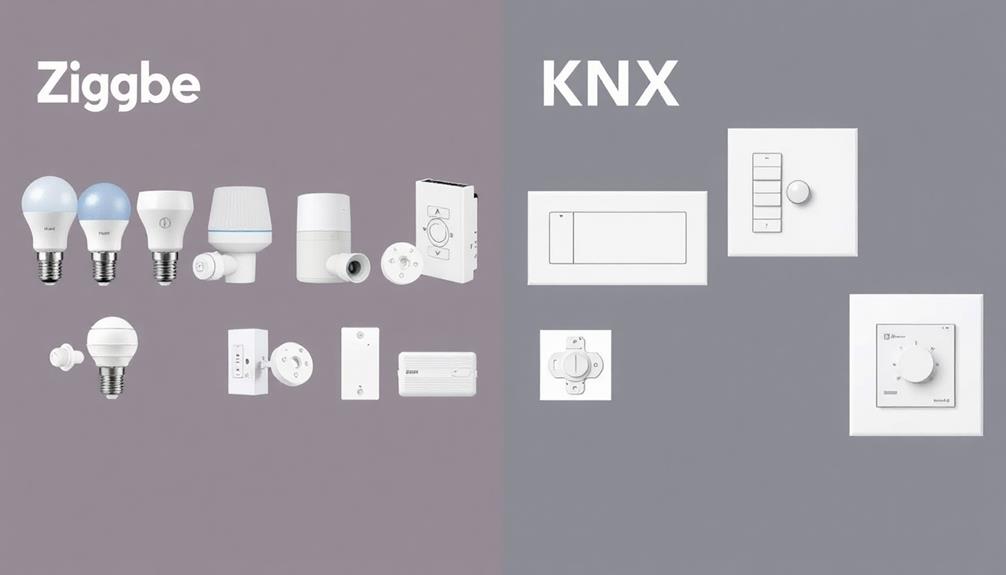
Device compatibility is essential for creating a cohesive smart home experience, as it directly affects how well various devices can work together. Zigbee devices generally have wider compatibility due to the standards set by the Zigbee Alliance, while KNX devices work seamlessly within a more limited ecosystem. Here's a quick comparison:
| Feature | Zigbee Compatibility | KNX Compatibility |
|---|---|---|
| Ecosystem Size | Large | Limited |
| Device Variety | Diverse (sensors, lights) | Primarily automation |
| Integration Ease | Moderate | High (within KNX) |
| Interoperability | Varies by cluster | Consistent |
| Gateway Support | Yes | Yes |
Choosing between Zigbee and KNX will depend on your specific needs for device compatibility in your smart home.
Interoperability Challenges

Interoperability challenges arise from the distinct communication protocols used by Zigbee and KNX, which can complicate the integration of devices from different ecosystems.
With Zigbee relying on a mesh network and KNX using a bus topology, you may find it hard to connect devices from both systems seamlessly.
In today's digital landscape, fostering creativity and collaboration is essential for overcoming such technical hurdles, as highlighted in fostering creative problem-solving.
While Zigbee devices generally work well within the Zigbee Alliance's standards, you might encounter issues when mixing clusters or types.
KNX, though robust in its ecosystem, may demand complex configurations to integrate new devices.
Utilizing gateway devices can help bridge these gaps, but you may still need custom middleware for effective data translation.
Addressing these interoperability challenges is crucial for creating a cohesive and functional smart environment.
Security Features Comparison
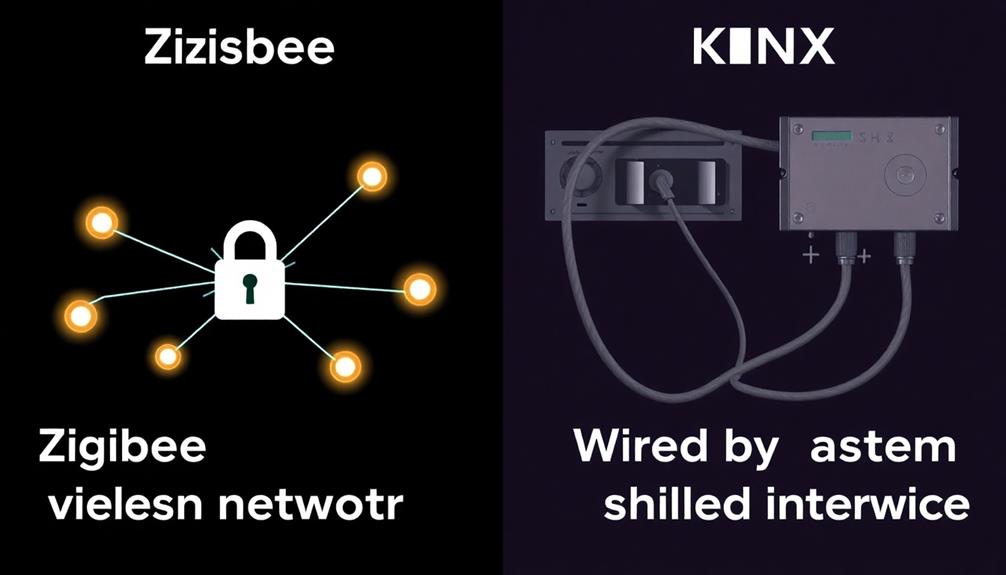
Security is paramount when evaluating smart home technologies like Zigbee and KNX. Both systems offer robust security features to protect your devices and data, but they do have differences worth noting:
- Advanced encryption to secure communications
- Strong authentication mechanisms for device access
- Secure key management protocols to protect cryptographic keys
- Tamper detection features to identify physical threats
- Regular updates to address potential vulnerabilities
Zigbee's mesh topology enhances security by allowing devices to communicate directly, while KNX's wired infrastructure offers a stable, secure environment.
However, both systems require diligent user practices and regular monitoring to guarantee ongoing security. By understanding these features, you can make an informed decision about which technology best fits your smart home needs.
Installation and Configuration
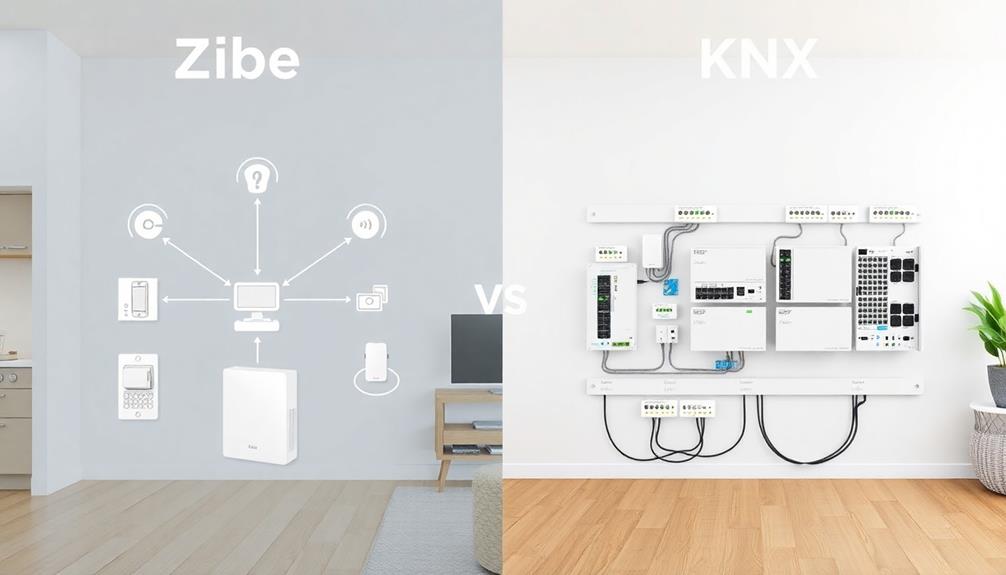
When considering installation and configuration, it's essential to recognize that Zigbee and KNX cater to different user needs and technical expertise.
Zigbee's setup is straightforward, allowing you to create a wireless network with minimal hassle. You can easily add devices and configure settings through user-friendly apps, making it perfect for DIY enthusiasts.
On the other hand, KNX requires professional installation due to its wired infrastructure and complex configuration processes. This can involve retrofitting existing structures, which may not be feasible for everyone.
While Zigbee offers flexibility and ease, KNX provides a more robust solution for larger systems. Your choice will depend on your technical skills and the specific requirements of your smart home or building automation project.
Cost Analysis
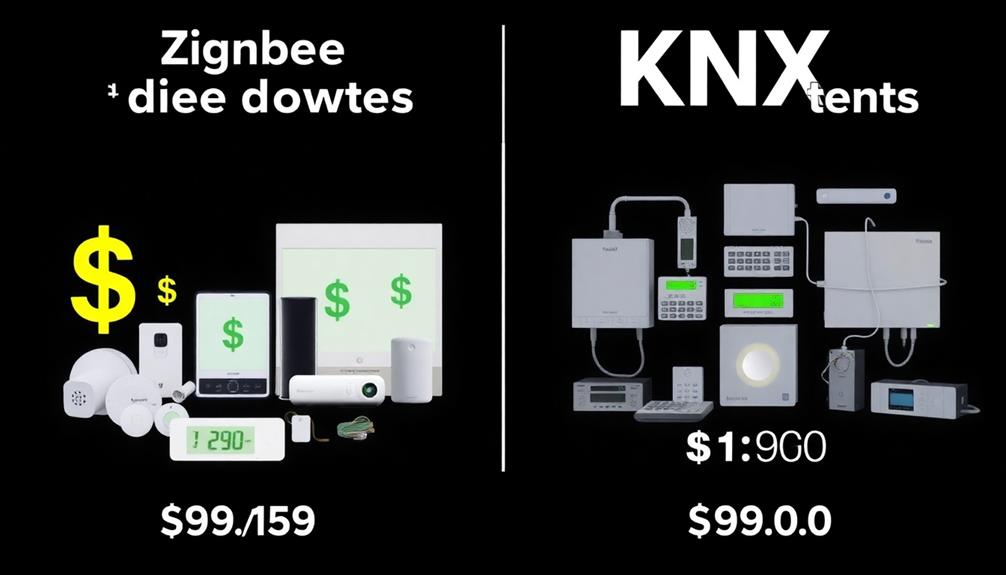
Cost considerations play an essential role in deciding between Zigbee and KNX for your smart home or building automation needs.
Here's what you should keep in mind:
- Initial Setup Costs: Zigbee is often cheaper to install than KNX due to its wireless nature.
- Professional Installation: KNX usually requires expert installation, adding to your overall expenses.
- Maintenance Expenses: Zigbee systems typically involve lower ongoing maintenance costs.
- Expansion Costs: Consider future scalability; Zigbee can be easier and more affordable to expand.
- Total Cost of Ownership: Evaluate long-term costs, including potential upgrades or replacements.
Application Areas and Benefits
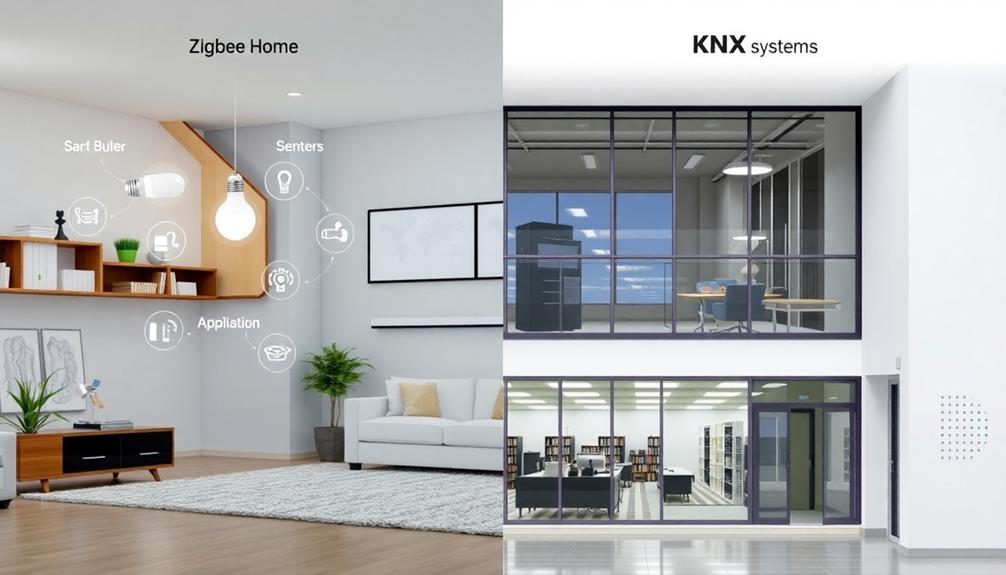
Leveraging the capabilities of Zigbee and KNX, you can enhance automation across various application areas, from smart homes to commercial buildings. Here's a quick look at their application areas and benefits:
| Application Area | Benefits |
|---|---|
| Smart Homes | Seamless control of lighting and security |
| Commercial Buildings | Efficient energy management and HVAC control |
| Healthcare Facilities | Remote patient monitoring and asset tracking |
| Industrial Automation | Precise control of machinery and conditions |
| Hospitality Sector | Enhanced guest experiences through automation |
Both systems offer significant advantages, such as improved energy efficiency, increased security, and a cohesive living environment. By choosing the right technology, you can optimize your space effectively.
Frequently Asked Questions
Which Devices Are Typically Powered by Zigbee Versus KNX?
You'll typically find Zigbee powering smart bulbs, sensors, and plugs, ideal for low-power applications. KNX usually powers more complex systems like lighting controls, HVAC units, and security systems, suitable for larger, wired installations.
How Do Zigbee and KNX Handle Device Updates?
"An ounce of prevention is worth a pound of cure." Zigbee handles updates wirelessly, making it straightforward for you. In contrast, KNX often requires manual updates, needing professional help for seamless integration. Choose wisely!
What Are the Range Limitations of Zigbee and KNX Systems?
Zigbee typically offers a range of up to 100 meters indoors and more outdoors, thanks to its mesh topology. KNX, being wired, has fewer range limitations but may require additional wiring for extensive coverage.
Can I Use Zigbee and KNX Together in One System?
You can integrate Zigbee and KNX in one system, enhancing your smart home. With Zigbee's 30-40% energy efficiency improvement, combining both technologies can optimize control and functionality across various devices for a seamless experience.
What Is the Average Lifespan of Zigbee and KNX Devices?
The average lifespan of Zigbee devices is around 5-10 years, while KNX devices can last 10-20 years. Factors like usage, environment, and maintenance affect longevity, so keep these in mind when planning your setup.
Conclusion
In the battle of Zigbee vs. KNX, your choice can shape the future of your smart home or building. Imagine a seamless space where every device communicates effortlessly, or a robust system that stands the test of time. Whether you lean towards Zigbee's flexibility or KNX's precision, understanding these protocols empowers you to create an environment that's not just smart, but truly yours. So, which path will you take to access your home's full potential?









